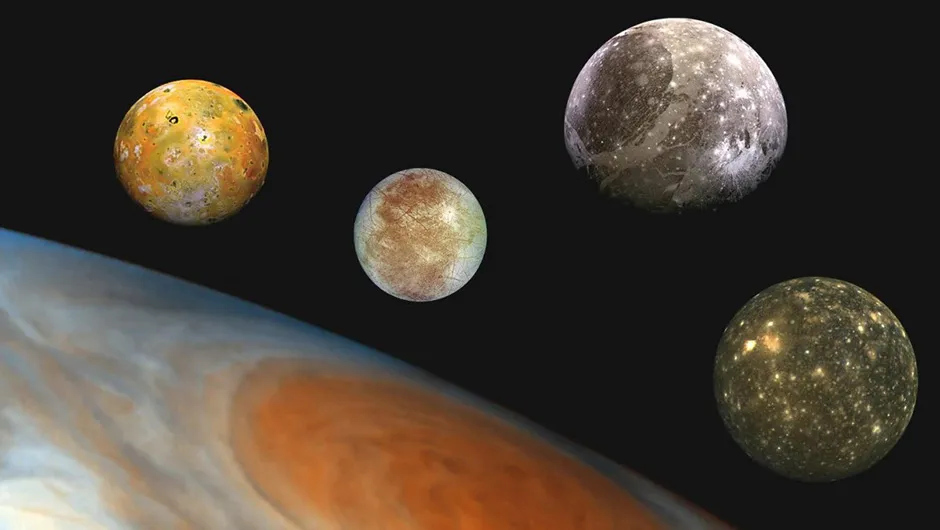The third largest of Jupiter's four ‘Galilean’ moons, Io is a volcanic hell – a world stained with putrid hues of yellow, brown and red. It is, in many ways, the antithesis of the likes of Jupiter's moon Europa. Yet that hasn’t stopped researchers from poring over every detail of its surface.
Io's volcanoes were confirmed in 1979 by planetary scientist Linda Morabito, who was part of NASA's Voyager team. Find out more about her discovery by reading our interview with Linda Morabito.
With ever improving ground-based technology and the Juno mission currently in the Jovian system, new insights into the activity of this pockmarked moon are being revealed every day.
There are even calls for a dedicated mission to explore this oddity among the outer planets.
One researcher whose work has recently attempted to shed light on Io’s violent volcanism is Professor Katherine de Kleer of the California Institute of Technology.
The varied colours across Io’s famously blotchy disc are almost all a result of some form of volcanic activity, she says.
“It’s all different sulphur-containing molecules that produce those different colours. Except for the dark regions – the black and grey deposits and lava flows are probably silicate.”
The volcanoes that create Io’s striking surface are littered all over the moon. The Galileo probe
– which took what are still the best close-up images of Io when it swooped past in the late 1990s and early 2000s – caught sight of glowing lava flows.
Meanwhile, other missions – including New Horizons and Hubble Space Telescope – have imaged vast, dome-shaped plumes of material erupting over Io’s limb.

Io's volcanoes
Hundreds of volcanoes are located across Io’s globe. Sometimes they stand out because scientists can detect their heat as an infrared glow, while others can be revealed thanks to tell-tale surface colouration.
“You assume that a dark lava flow is young because it still has to be warm for it to stay dark,” explains de Kleer.
“If it were cooled completely the sulphur dioxide would freeze out of the atmosphere on to it and it wouldn’t be dark anymore. So even where you don’t see the infrared emission, you can infer that something’s been active within the past couple of years.”
De Kleer’s own work has involved looking at Io with powerful ground-based facilities, like the Keck Observatory telescope in Hawaii.
By observing the moon at infrared wavelengths, de Kleer and her colleagues were able to get a very different view of Io.

“The disc is bright because the sulphuric frosts on its surface are reflecting sunlight,” says de Kleer.
“But then on top of that you see these really bright little spots all over Io’s surface. These spots are infrared emission from the heat coming off these individual active volcanic regions.”
The Juno spacecraft – currently whirling around Jupiter – also looks at Io in infrared; in imagery captured in 2017, it was able to detect signs of a glowing patch of volcanic activity where there seemingly hadn’t been one before.
This thrilling level of geological dynamism is something that can be seen in Earth-based infrared observations too.
“Taking pictures from night to night you can see the different volcanoes [that] are active or not active,” explains de Kleer.
“They’re giving off different amounts of heat and you can see that by just observing several nights in a row at a telescope; you can see how it’s changing.”

What do Io's volcanoes look like?
If we were able to get up close to these volcanoes, the sulphur deposits may appear similar to those seen around volcanic features on Earth, such as in Lassen Volcanic National Park and Yellowstone in the US, expains de Kleer.
“You can probably imagine something like that but scaled up,” she says.
The actual shapes of the volcanoes are likely to be a far cry from towering, pointed peaks, however, due to the nature of the material they form from.
“We think the magmas that are erupting on Io are at the upper end of the temperatures for things we see on Earth – maybe hotter,” says de Kleer.
This high temperature, along with the magma’s lower silica content compared to Earthly analogues, means that when lava does break out onto Io’s surface it’s thought to be particularly runny, and it can flow over long distances rapidly.

What produces Io's volcanoes?
Io’s volcanism is thought to arise from the gravitational dance the moon performs with Jupiter, Europa and Ganymede; this creates a force that repeatedly pulls and squashes the 3,640km-wide Io.
“You have this pretty rapid deforming of its shape every couple of days that generates friction in its interior and produces heat,” explains de Kleer. “It’s sufficient to melt rock.”
One of the most spectacular results of the molten mayhem going on under Io’s surface is the volcanic feature in the moon’s northern hemisphere known as Loki Patera.
This huge magma lake measures some 180km across and has been the focus of recent research by de Kleer and her colleagues.
Using the Large Binocular Telescope (LBT) – sited in Arizona, in the US – the scientists watched as Jupiter’s moon Europa passed in front of Io.
Ordinarily it’s tricky to resolve detail on Loki Patera when observing in infrared light from the ground, but the passage of Europa allowed them to perform a clever observation.
As Europa gradually obscured the vast volcano, the team could measure the infrared glow from relatively small sections of it – since they could work out precisely which bits were visible, and therefore glowing, at a given moment.
This, coupled with the power of the LBT’s optics – which function as if they were one immense 23m-wide mirror – allowed de Kleer and her fellow researchers to perform something akin to a ‘scan’ of the infrared signature of Loki Patera:

The infrared ‘map’ the team were able to create is part of a broader effort to try to figure out the nature of what de Kleer calls the ‘plumbing system’ that joins Io’s depths to its surface.
“What that connection system looks like is pretty much totally unknown. And to say anything about what that looks like you really have to get very good spatial resolution on a single volcano,” she says.
While researchers continue to watch Io from the ground and in space, there are those who are also pressing for a dedicated mission – currently referred to in preliminary proposals as the Io Volcano Observer (IVO) – to travel to Jupiter in order to explore the moon in much greater detail.
“It would be able to get a totally different type of information and be very complementary,” explains de Kleer.
“When you’re in the system you can measure the gravity field and magnetic field and those tell you about the interior of an object in a way that nothing else really can.”
As planetary scientists wait to see if they will be granted their mission, two things are clear: Io’s volcanoes show no signs of settling down; and just as its surface is destined to continue changing, so will our understanding of this distant, enigmatic, world.
How did Jupiter's Galilean moons form?

As scientists consider sending missions to Jupiter in the coming years, one question that remains about the Galilean moons, Io included, is how did they form?
The prevailing theory suggests it could have been a relatively rapid process; the moons combined from kilometre-sized objects encircling Jupiter in as little as a hundred thousand to a million years.
Now, though, new research by Dr Yuhito Shibaike, at the University of Bern, and colleagues argues the process may have been much slower – perhaps taking something like 10 million years.
In this new theory the chunks gathering together would have been smaller too, measuring only centimetres across.
Among the evidence for the new theory is the fact that Europa actually possesses relatively little water, suggests Shibaike.
“In our scenario, Europa got water only after the gas disc became cooler, at the very last moment of the formation, resulting in the very small amount of water on the moon,” he explains.
“However, if the accreting bodies are large, only the water on their surfaces is lost and most
of the water remains inside them. Therefore in the classical scenario, Europa should have got a lot of water through the entire formation period.”
Will Gater is an astronomer and a science writer and journalist. This article originally appeared in the July 2020 issue of BBC Sky at Night Magazine.
